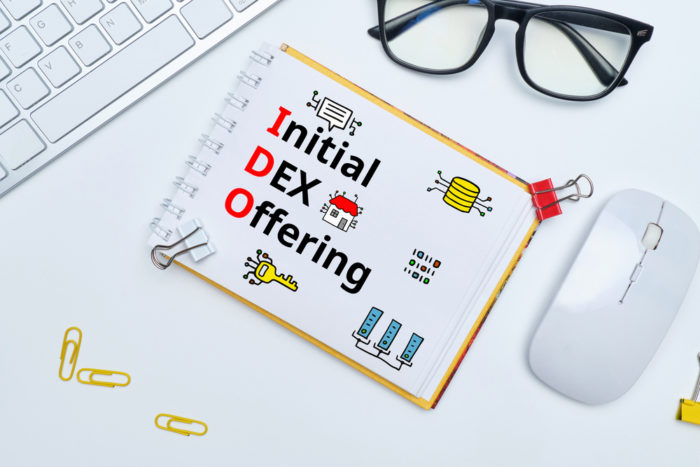Table of Contents
An IDO is a cryptocurrency token offering on a (DEX) Decentralized Exchange. Liquidity pools (LP) play an essential role in IDOs by providing liquidity after the sale. A standard IDO allows users to deposit cash in exchange for new currency during the token creation event. Some of the monies received are added to an LP before returning to the project later.
IDOs allow projects to release their tokens in a low-cost and straightforward manner. IDOs have existed for some time, but they continually change and offer new models, such as the Initial Farm Offering (IFO).
IDOs have grown in popularity, but how does it work, and are they safer for traders?
What Exactly Is an IDO?
IDOs are tokens that represent any asset held on a decentralized exchange (DEX) — when a program distributes a token over a decentralized liquidity market. IDOs may be constructed for anything from money to a music CD to aether-powered combat ships. IDOs provide businesses with a mechanism for involving their customers in an economy that improves their products or services and allows them to make smarter business decisions about their assets.
Similar to how traditional firms acquire venture cash before launching, early DEX offerings are funded by individual investors. First dex offers differ from initial public offerings in that investors never get stock in the enterprise.
IDOs may be more popular than ICOs and IEOs since they offer quick liquidity, quick trading, and cheaper listing expenses.
In contrast, IDOs can provide a considerably more cost-effective token sale and marketing approach. To begin with, an IDO delivers immediate liquidity with minimal to no slippage through accessible liquidity pools in a DEX. It has lower listing charges in comparison. And, like IEOs, it enables direct trade.
How Does an IDO Function?
An IDO employs a decentralized exchange (DEX) to support token sales. The DEX receives tokens from a crypto project, users contribute funds through the network, and the DEX fulfills the ultimate distribution and transfer. These procedures are automated and take place via blockchain smart contracts.
Like an ICO, a creator must develop a project and a token for it.
Remember that the IDO is not the same as the coin it sells. Investors will utilize the Initial DEX Offering bitcoin to exchange or purchase for utility within the project when it begins.
The project will be published on the DEX after a whitepaper for the token has been developed. The tokens are now accessible at a low cost. In exchange for these tokens, users begin to fund the initiative. The notion is that their prices may increase at the start of the project. As a result, profit.
The money raised during the IDO goes into a liquidity pool. The liquidity pool will be accessible for trade once the project is launched. Investors that purchased the token beforehand can begin trading right away.
The Advantages of IDO
Blockchain networks and issuers can profit from the IDO crypto funding model in various ways.
Increased Liquidity
Initial DEX Offerings don’t use a price oracle like IEOs. IDOs employ an automated market maker to define the token market based on collateral availability in decentralized exchange liquidity pools. Because the ratio of coins to collateral in liquidity pools changes when a token is bought or sold, the price of an asset on a DEX with an automated market can only change when a token is purchased or sold. It streamlines modest currency trades, giving the project’s token instant liquidity.
Reduced Costs
Another advantage of IDO is its minimal fees. Project teams must pay a gas price to install a new smart contract using IDOs. The liquidity pool and the asset’s token are both controlled by this smart contract.
Fast Trade
Once the tokens have been issued, IDOs allow rapid trading. As a result, investors can purchase tokens as soon as they are released and then resell them at a higher cost later during the IDO. For instance, during the fundraising for the UMA protocol, the original token value of $0.26 quickly soared to about $2.
The Disadvantages of an IDO
Something of this magnitude nearly always entails some level of danger. IDOs have certain intrinsic drawbacks, although they aren’t severe.
Control Issues
No KYC (Know your customer) or any applicable policy because no sign-up is required. Anyone may join without divulging their identity or the source of their finances.
Before undertaking the project, make sure to conduct your homework and find a reliable platform.
It’s Simple to Establish
Almost anyone with minimal technical knowledge can manufacture a token and establish an IDO because of the low expenses. It might be challenging to determine who you’re dealing with. It might be a red flag if a project makes too many promises or seems too nice.
Conclusion
IDOs have become a typical method for many new crypto projects to raise money because they are easy to use, cheap, and easy to access. Token sales have grown into their own business. To sum up, participating in a deal through a Decentralized Liquidity Exchange is usually safer than taking part in a project. Still, selecting the right project is a big part of how well an IDO does.

